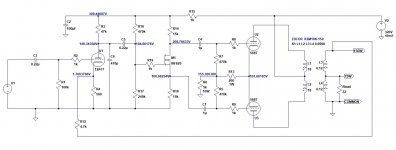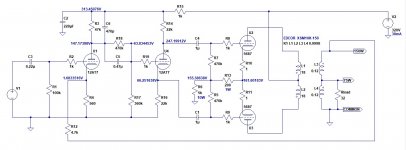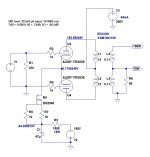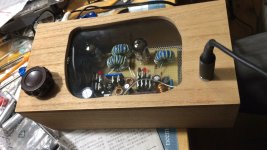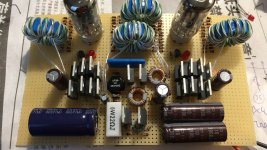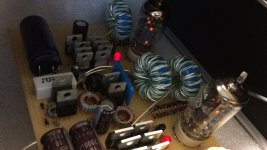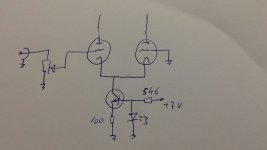Sorry, do you mean with a 12AT7 voltage amp into a 12AT7 split-load phase inverter driving the two 5687 grids? But of course! Only I'm not sure that's what you're asking for...
Also, that will be difficult-to-impossible to do well with only a +320V B+. 12AT7 doesn't do well with plate voltages below about 150V.
How about a 12AT7 RC-coupled to an IRF820 'Source-o-dyne'?
Here's what I got.
THD goes up, but I haven't played with this a whole lot.
1kHz sine wave in, 536mV pk = 1V RMS out into 32 ohms.
THD = 0.045% H2 -67dB, H3 -83dB, so H3 is -16dB below H2.
I think the source-o-dyne removes some of the distortion cancellation action. The added complexity brings no reward.
I'm sure there's a better way to do this, though.
--
Also, that will be difficult-to-impossible to do well with only a +320V B+. 12AT7 doesn't do well with plate voltages below about 150V.
How about a 12AT7 RC-coupled to an IRF820 'Source-o-dyne'?
Here's what I got.
THD goes up, but I haven't played with this a whole lot.
1kHz sine wave in, 536mV pk = 1V RMS out into 32 ohms.
THD = 0.045% H2 -67dB, H3 -83dB, so H3 is -16dB below H2.
I think the source-o-dyne removes some of the distortion cancellation action. The added complexity brings no reward.
I'm sure there's a better way to do this, though.
--
Attachments
Why would the MOSFET present a heavy load to the ECC81? Do you mean its input capacitance? Remember that it's a follower, with no gain, so its gate capacitance will remain low and its input impedance is extremely high.
The reason I didn't use a tube there is because of the low voltages. Since the output stage uses a 5687, the total B+ (Ebb) is only +320V. For a concertina, that would be cut into thirds. But I want at least 150V at the anode of the ECC81, not Va = 100V.
An ECC88 (6DJ8) would work, but what we wanted to see was how the ECC81's dominant 2nd harmonic characteristics would affect the output stage. The answer is that using the ECC81 as the input voltage amp stamps its harmonic signature on the output. 3nd harmonic remains at least 16dB lower than 2nd harmonic at the output, all the way up to clipping.
I could use ECC88 in place of the ECC81 and the IRF820, and DC-coupled as well. But now the 3rd harmonic will be equal in level to the 2nd harmonic at the output, even with -10dB gNFB applied.
--
In the end, I'm not sure the phase splitter is necessary. The output stage can do the phase splitting, a la Oddwatt.
--
The reason I didn't use a tube there is because of the low voltages. Since the output stage uses a 5687, the total B+ (Ebb) is only +320V. For a concertina, that would be cut into thirds. But I want at least 150V at the anode of the ECC81, not Va = 100V.
An ECC88 (6DJ8) would work, but what we wanted to see was how the ECC81's dominant 2nd harmonic characteristics would affect the output stage. The answer is that using the ECC81 as the input voltage amp stamps its harmonic signature on the output. 3nd harmonic remains at least 16dB lower than 2nd harmonic at the output, all the way up to clipping.
I could use ECC88 in place of the ECC81 and the IRF820, and DC-coupled as well. But now the 3rd harmonic will be equal in level to the 2nd harmonic at the output, even with -10dB gNFB applied.
--
In the end, I'm not sure the phase splitter is necessary. The output stage can do the phase splitting, a la Oddwatt.
--
Last edited:
In simulation using Ale M's 6J52P-triode model, a pair of triode-strapped 6J52P with a ccs tail into an Edcor XSM10K-150 yields sufficient gain and output level for a tiny push-pull headphone amp. The open loop distortion comes out very low, with the 2nd harmonic dominating.
The rp of the 6J52P-triode must be a little higher than that of the 5687, as f3 in the bass is a little bit higher. Still perfectly OK at -1dB at 22Hz.
I'm using a model of an Edcor XSM10K-150 OPT with winding inductances and resistances from real life measurements. I guessed at the leakage inductance to get the output frequency response to match Edcor's claimed FR. The two halves of the primary don't have the same resistance, and I retained that in the model. That actually increases the 3rd harmonic generated, so I think this simulation should translate reasonably well to real life. Would be a simple build. The only worries are microphonics and oscillation, as the 6J52P is a demanding little bugger.
--
The rp of the 6J52P-triode must be a little higher than that of the 5687, as f3 in the bass is a little bit higher. Still perfectly OK at -1dB at 22Hz.
I'm using a model of an Edcor XSM10K-150 OPT with winding inductances and resistances from real life measurements. I guessed at the leakage inductance to get the output frequency response to match Edcor's claimed FR. The two halves of the primary don't have the same resistance, and I retained that in the model. That actually increases the 3rd harmonic generated, so I think this simulation should translate reasonably well to real life. Would be a simple build. The only worries are microphonics and oscillation, as the 6J52P is a demanding little bugger.
--
Last edited:
Sorry, do you mean with a 12AT7 voltage amp into a 12AT7 split-load phase inverter driving the two 5687 grids? <snip>
Try a self-biased 12AT7 concertina in place of the mosfet, and see how it does. That, or the resistor-divider bias I used on my flea amplifier.
Adjust parts values to suit, of course... I bet you will get a little better results than the fet here, since the tube has a bit of "bend" going on that the fet doesn't, even with such heavy degeneration from acting as a follower/concertina.
I think it was late last night. I think this can work.
+300V B+
Concertina with 22k plate and cathode load resistors.
12AT7 running at 3mA Ip, dropping 66V each across Rp and Rk.
That's 132V subtracted from the B+ of 300V, leaving Vg-k of 168V. I should be able to bias the 12AT7 at Vg of about -1.5V.
Works for me! I'll try it when I get back to my 'pooter this evening.
--
+300V B+
Concertina with 22k plate and cathode load resistors.
12AT7 running at 3mA Ip, dropping 66V each across Rp and Rk.
That's 132V subtracted from the B+ of 300V, leaving Vg-k of 168V. I should be able to bias the 12AT7 at Vg of about -1.5V.
Works for me! I'll try it when I get back to my 'pooter this evening.
--
Here's the PP 5687 with a 12AT7 cathodyne. It measures pretty much the same as the PP 5687 with 12AT7 voltage amp and MOSFET source-o-dyne. THD with 12dB of gNFB is about 0.04% with 1V RMS out into 32 ohms.
The 12AT7 voltage amp driving 5687 LTP by itself yields only very slightly higher THD, due to slightly higher 3rd harmonic level. 2nd harmonic still dominates.
--
I don't think PP 6SN7 will work with this particular OPT, as it has inadequate primary inductance for the 6SN7's higher rp of 7k to 9k ohms. By comparison, a 5687 (or 6N6P) with Ip = 20mA will have rp of about 1.8k or so. That's a big difference.
--
The 12AT7 voltage amp driving 5687 LTP by itself yields only very slightly higher THD, due to slightly higher 3rd harmonic level. 2nd harmonic still dominates.
--
I don't think PP 6SN7 will work with this particular OPT, as it has inadequate primary inductance for the 6SN7's higher rp of 7k to 9k ohms. By comparison, a 5687 (or 6N6P) with Ip = 20mA will have rp of about 1.8k or so. That's a big difference.
--
Attachments
I bet the step network bias will work with a mosfet instead of the 12AT7 just fine, come to think of it. Still sounds like pretty good results though. Running a triode for the cathodyne makes for a one bottle per channel front end, which will satisfy folks that are nervous about crosstalk, even if it is an additional bottle and socket per channel.
It's 8k Ra-a and rated for 15 Watts.The Shishido design used a Tango U-15-8 which nobody seems to know anything about but I wonder if the "15" refers to a 15k primary and perhaps the "8" is the wattage rating??
Lingwendil said:I bet the step network bias will work with a mosfet instead of the 12AT7 just fine, come to think of it.
That 'step network' otherwise known as 'level shifting' and fixed bias using a resistive voltage divider work out the same. So yes, either will work with the MOSFET or triode. I could have done a level shifting arrangement with the MOSFET but chose to do fixed bias instead. I could have done either one.
Lampie519 said:Yes, that one looks cool !
Which one? The 12AT7 cathodyne, or the dual 6J52P-triode LTP?
--
It's 8k Ra-a and rated for 15 Watts.
Thanks for the info. An optimum load for PP 12BH7s should be ~21.5k but I guess it was at least functional and the Fisher 500c units that Kaufman used were about the same at 7.5k.
Sadly, here in Europe we don't have that easy access to the tubes you've named. Our cheaper alternative for the ECL82/6BM8 would be the PCL82/16A8. Not 1$ tubes, though.
Best regards!
You have access. I regularly buy from US. Of course there are taxes and shipping so they won't cost $1 but still cheaper than standard types.
I have recently bought 12x 6HB6 (RCA and GE) for $5 each and 8 x 10GK6 Sylvania for $4 each, including taxes and shipping. All really new in their original boxes.
The 10GK6 is the 10V heater version of the 6GK6 which in turn is basically an up-rated EL84 (different pinout). Surely a lot better than any current production EL84.
By the way I have lots of PCL82's and a good number of ECL82's. I hadn't realised how expensive they have become....I used to pay the PCL82 1 euro each some 10 years ago.
I think I like this one.
PP 6J52P-Triode with DN2540 CCS into Edcor XSM10K-150 OPT
Very low THD, 2nd harmonic dominates. The only downside is very low gain of <2X (less than 6dB).
--
The gain of this circuit is less than 2 times, which is unlikely!
For a bit more flea power, there is the 6HZ8, which is on the $1 list at ESRC.
8 W pentode and 1 Watt triode, Mu 70. 9 pin mini Fatboy tube.
ESRC ? What is it ? Thanks
Last edited:
- Status
- This old topic is closed. If you want to reopen this topic, contact a moderator using the "Report Post" button.
- Home
- Amplifiers
- Tubes / Valves
- Can we discuss PP Flea amps for hi-fi
